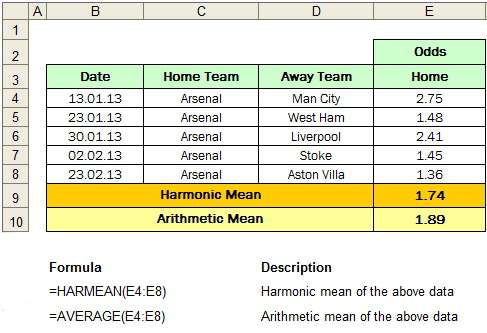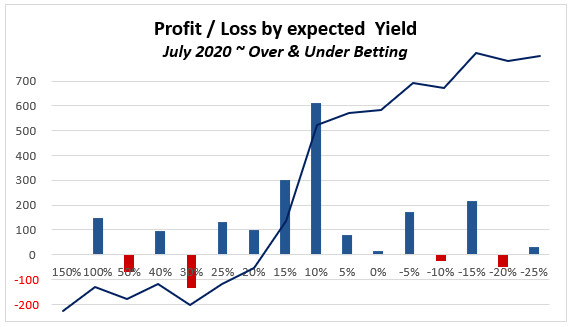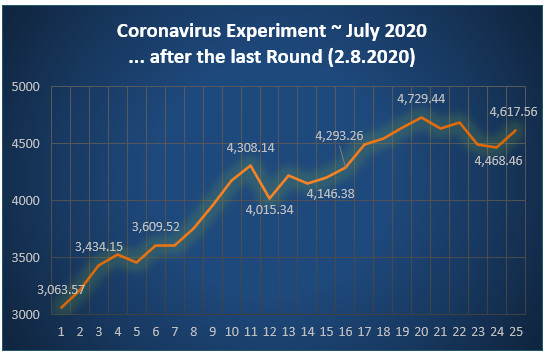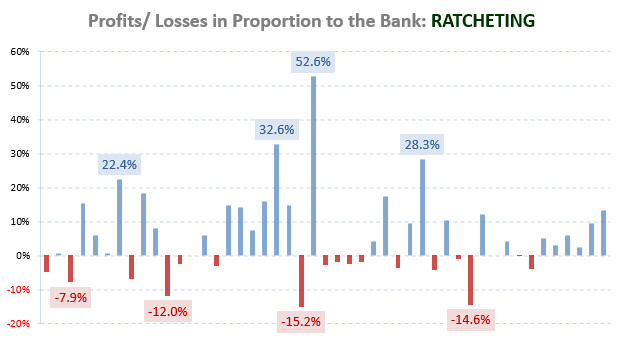
Example of Harmonic Mean
Understanding formulas and calculations is always best done using a tactile example…
In return for this freebie we would appreciate if you could share this article via your social network or give us a ‘thumbs-up’ with a ‘love’ or ‘like’ via Twitter or Facebook 🙂
Note: The calculations provided in this download include more data and sample calculations than shown in this article.
Breaking down the Arsenal example into an easier workable chunk, we will now compare the harmonic and arithmetic mean of just 5 of their recent home matches:

The calculation of the harmonic mean:


For comparison, the calculation of the arithmetic mean:
You can clearly see that the two methods produce different results and therefore, basing long complicated analyses and studies on the wrong intermediate result (i.e. using the arithmetic mean rather than the harmonic mean), will ultimately leave you just as far from consistently positive betting results than you were before beginning your odyssey!
Should this be a new topic for you then Soccerwidow recommends playing around with computing average odds and, for example, practising the harmonic mean calculation (using the highest betting odds you can find for the market) for the whole of a league’s season.
It may come as a surprise to some and perhaps enlighten others to discover that the harmonic mean of a season’s odds reflects the observed average distribution of results pretty closely, far closer than the arithmetic mean (which is commonly, but wrongly used for calculating ‘the average odds’).
How do those sly bookmakers achieve this? 😉







Came across the article here whilst browsing – informative, even for a maths person like myself. My question is: what does harmonic mean GIVE us? Is it the ‘average’ odds per match, whose common value would give us the same returns as the originals? I have been playing with a spreadsheet, using only 3 values (3/1, 2/5 and 9/4 (aka 4.00, 1.4 and 3.25)) which gives a HM of 2.3585, but I can’t make the formulae work to give me the same returns as the calcs using the original values individually as an accumulator. Any possibility of a worked example? Regards A
Hello Soccerwidow!
Can you tell me please, how are the Asian Handicap markets calculated?
Thanks,
Hi sarkec, ASH calculation is going to be a whole course, much more massive than the OU course. It’s a very tricky calculation. Cannot be explained in few words. Sorry.
Hi,
When averaging the two zero odds for a home and away team in your over/under course, you use the arithmetic mean rather than the harmonic mean. In your example of U4.5 in the Wolfsburg v Bayern match the numbers are 1.16 & 1.24 so both averages come out quite close to 1.2
However, looking at U 2.5 in the same tables, using odds of 2 & 3 you get a arithmetic avg of 2.5 and harmonic of 2.4 which could potentially alter a decision as to value in the bet.
Could you please confirm which is correct and why?
Many thanks!
Hi Aussiebettor, I think you found an error in the course which needs to be amended. Using the harmonic mean for building average odds is correct.
Anyway, the course is due for review, and I will attend to it.
Very interesting article indeed. Would you use harmonic mean average if you we’re say calculating the average shots or corners taken by a given team over the season ?
Shots and corners are countable variables; they can be sorted into a natural order and possess a zero point. Therefore, these variables belong to the ratio scale, and for calculating of the average the ‘normal’ average mean is being used. Harmonic and geometric mean are pretty meaningless for this kind of variables.
You may find this article useful: Correct Assignment of Football Data to Levels of Measurement
Hi Soccerwidow,
Do you have any idea of how the over/under of a soccer match is priced please?
I do not think that it is automatically extracted from the 1×2 right ?
Thanks in advance.
Hi Betevo, correct, over/under odds are NOT automatically extracted from the 1X2 market.
You may be interested in my course on Over/Under odds calculation: Soccerwidow’s Football Betting Course – How to Calculate Odds: Betting on Over / Under ‘X’ Goals
Hi there,
Anyone that know where to find the following Calculator:
1) giving input in the form of odd for Over / under 2,5 & the odd for 1,X,2 outcome.
Giving estimated fair odd for ALL result from 0-0 to 9-9,
Thanks in the advance
Hi Goran,
it’s unfortunately not that easy.
However, here is a link to a calculator which will give you some probabilities if you put in the goal averages home & away: http://www.winnergambling.com/sports-betting-bingo/correct-score-betting-alculator/
Thanks for the link, Soccerwidow; unfortunatelly, it seems to be just simple Poisson distribution, that could be easily done in Excel as well, and is known as not really accurate, so nothing special…
Very interesting. Could one also use a geometric mean? My school maths is rusty but doesn’t a geometric mean provide a “typical value”, while a harmonic mean leans towards smaller figures in the set at the expense of larger ones?
The geometric mean is used for describing proportional growth, e.g. in business the geometric mean of growth rates is known as the compound annual growth rate (CAGR). In betting, the geometric means calculates the growth rate of success (profits/losses).
I’m in the process of writing an educational paper on this so keep looking…